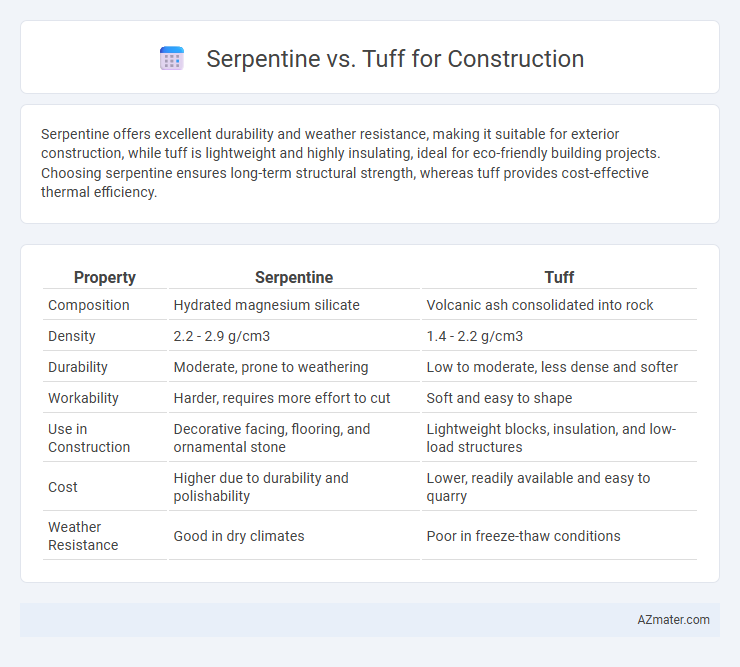Serpentine offers excellent durability and weather resistance, making it suitable for exterior construction, while tuff is lightweight and highly insulating, ideal for eco-friendly building projects. Choosing serpentine ensures long-term structural strength, whereas tuff provides cost-effective thermal efficiency.
Table of Comparison
| Property | Serpentine | Tuff |
|---|---|---|
| Composition | Hydrated magnesium silicate | Volcanic ash consolidated into rock |
| Density | 2.2 - 2.9 g/cm3 | 1.4 - 2.2 g/cm3 |
| Durability | Moderate, prone to weathering | Low to moderate, less dense and softer |
| Workability | Harder, requires more effort to cut | Soft and easy to shape |
| Use in Construction | Decorative facing, flooring, and ornamental stone | Lightweight blocks, insulation, and low-load structures |
| Cost | Higher due to durability and polishability | Lower, readily available and easy to quarry |
| Weather Resistance | Good in dry climates | Poor in freeze-thaw conditions |
Introduction to Serpentine and Tuff in Construction
Serpentine and tuff are widely used natural stones in construction, valued for their unique properties and aesthetic appeal. Serpentine is a durable, greenish metamorphic rock with good thermal insulation and resistance to weathering, making it ideal for exterior cladding and decorative elements. Tuff, a volcanic ash-based igneous rock, is lightweight and easy to cut, often used for load-bearing walls, facades, and historical restoration projects.
Geological Formation and Characteristics
Serpentine, formed through the hydration and metamorphic transformation of ultramafic rocks in subduction zones, exhibits a greenish hue with a smooth, often fibrous texture, making it relatively soft and prone to weathering. Tuff originates from consolidated volcanic ash deposits during explosive eruptions, characterized by its porous, lightweight nature and variable hardness depending on compaction and mineral content. The geological formation of serpentine contributes to its susceptibility to chemical alteration, whereas tuff's volcanic origin often imparts better thermal insulation properties and ease of shaping in construction.
Physical and Mechanical Properties Comparison
Serpentine exhibits a relatively low compressive strength ranging between 40 and 80 MPa with moderate hardness and poor durability against weathering, making it less ideal for structural applications. In contrast, tuff, composed of consolidated volcanic ash, offers higher porosity and lower density but demonstrates improved compressive strength typically around 20 to 50 MPa, coupled with good thermal insulation properties and ease of shaping for masonry work. The choice between serpentine and tuff depends largely on the balance between mechanical strength requirements and specific use cases involving thermal performance or aesthetic considerations in construction design.
Durability and Weather Resistance
Serpentine rock offers moderate durability but tends to be less weather-resistant due to its susceptibility to chemical weathering and hydration, making it less ideal for exterior construction in harsh climates. Tuff, a volcanic ash-based rock, exhibits high porosity which can reduce its durability but often possesses better weather resistance through natural cementation and mineral composition that withstands freeze-thaw cycles. The choice between serpentine and tuff for construction depends on specific environmental conditions, with tuff generally favored for projects requiring enhanced resistance to weather-induced decay.
Aesthetic Appeal and Color Variations
Serpentine offers a distinctive aesthetic appeal with its rich green hues and smooth, glossy finish, making it a popular choice for decorative facades and interior accents. Tuff, in contrast, displays a more muted, earthy palette ranging from light beige to rusty brown, providing a rustic and natural look ideal for structural and landscape applications. Both materials present unique color variations that cater to diverse architectural styles, with serpentine's vibrant shades suited for modern designs and tuff's subtle tones blending seamlessly into natural environments.
Workability and Ease of Installation
Serpentine exhibits excellent workability due to its relatively fine-grained texture and moderate hardness, allowing for easy cutting and shaping with standard masonry tools. Tuff, being a lightweight volcanic rock with a porous structure, is exceptionally easy to handle and install, reducing labor time and effort on construction sites. Its softness also enables simpler drilling and fastening compared to denser stones like serpentine, making tuff preferred for rapid installation and projects requiring intricate detailing.
Environmental Impact and Sustainability
Serpentine and tuff differ significantly in environmental impact and sustainability for construction; serpentine, often containing asbestos fibers, poses health risks and requires careful handling to mitigate airborne contaminants. Tuff, a volcanic rock, offers a more sustainable option due to its natural abundance, low energy extraction process, and excellent thermal insulation properties that reduce building energy consumption. Using tuff can contribute to greener construction practices by minimizing ecological disturbance and promoting long-term durability with fewer maintenance demands.
Cost Analysis and Availability
Serpentine rock, commonly used in decorative construction, tends to have higher costs due to limited quarrying locations and increased processing requirements, whereas tuff is generally more affordable, benefiting from widespread availability and easier extraction. Tuff's abundance in volcanic regions reduces transportation expenses, making it a cost-effective choice for bulk construction materials. When considering long-term budgets, tuff offers better value for large-scale projects, while serpentine may be preferred for specialized architectural applications despite its premium price.
Typical Applications in Modern Construction
Serpentine is favored in modern construction for decorative applications such as cladding, flooring, and countertops due to its attractive green hues and smooth texture, which provide both aesthetic appeal and moderate durability. Tuff, a volcanic ash-based rock, is typically used for structural components like walls, foundations, and lightweight blocks because of its excellent insulating properties, ease of shaping, and cost-effectiveness. Both materials contribute uniquely to sustainable building practices, with serpentine offering natural beauty and tuff delivering thermal efficiency and structural support.
Conclusion: Choosing Between Serpentine and Tuff
Serpentine offers durability and resistance to weathering, making it suitable for decorative stone applications, while tuff provides lightweight and excellent insulating properties ideal for structural uses. Consider project requirements: serpentine excels in aesthetic appeal and long-term strength, whereas tuff is cost-effective and easier to work with in large-scale construction. Selecting between serpentine and tuff depends on balancing factors such as load-bearing needs, thermal insulation, budget constraints, and design preferences.

Infographic: Serpentine vs Tuff for Construction
 azmater.com
azmater.com